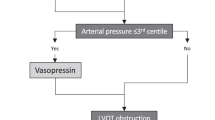Abstract
Biological abnormalities simulating Bartter syndrome were observed in a preterm neonate with complex cyanotic congenital heart disease, for which ductus arteriosus was maintained open by high doses of prostaglandin (PG) until a Blalock shunt could be performed. These abnormalities spontaneously disappeared after cessation of PG administration. We postulate that the natriuretic effect of exogenous administered PG could further increase sodium wasting already induced by the cardiopathy thus leading to pseudo-Bartter syndrome.
Similar content being viewed by others
Abbreviations
- PG:
-
prostaglandin
References
Bartter FC, Pronove P, Gill JR jr, MacCardle RC (1962) Hyperplasia of the juxtaglomerular complex with hyperaldosteronism and hypokaliemic alkalosis. Am J Med 33:811–828
Bartter FC, Rodriguez LF (1982) Bartter's syndrome. In: Frick P, von Harnack GA, Kochsiek K, Martini GA, Prader A (eds) Advances in internal medicine and pediatrics. Springer, Berlin Heidelberg New York, pp 79–103
Costello J, Bourke E (1983) Bartter's syndrome — the case for a primary potassium-losing tubulopathy: a discussion paper. J R Soc Med 76:53–56
Fichman MP, Telfer N, Zia P, Speckart P, Golub M, Rude R (1976) Role of prostaglandins in the pathogenesis of Bartter's syndrome. Am J Med 60:785–797
Folger GM jr, Hollowell JG (1972) Excretion of catecholamine in urine by infants and children with cyanotic congenital heart disease. Pediatr Res 6:151–157
Fujita T, Ando K, Sato Y, Yamashita K, Nomura M, Fukui T (1982) Independent roles of prostaglandins and the renin-angiotensin system in abnormal vascular reactivity in Bartter's syndrome. Am J Med 73:71–76
Guignard J-P, Torrado A, Da Cunha O, Gautier E (1975) Glomerular filtration rate in the first three weeks of life. J Pediatr 87:268–272
Jamison RL, Ross JC, Kempson RL, Sufit CR, Parter TE (1982) Surreptitious diuretic ingestion and pseudo-Bartter's syndrome. Am J Med 73:142–147
Kurtzman NA, Guttirez LF (1975) The pathophysiology of Bartter's syndrome: hypothesis. JAMA 234:758–759
Littlewood JM, Lee MR, Meadow SR (1976) Treatment of childhood Bartter's syndrome with indomethacin. Lancet II:795
Massa G, Proesmans W, Devlieger H, Vandenberghe K, Van Assche A, Eggermont E (1987) Electrolyte composition of the amniotic fluid in Bartter's syndrome. Eur J Obstet Gynecol Reprod Biol 24:335–340
Nakai T, Yamada R (1983) Urinary catecholamines excretion by various age groups with special reference to clinical value of measuring catecholamines in newborns. Pediatr Res 17:456–460
Author information
Authors and Affiliations
Rights and permissions
About this article
Cite this article
Langhendries, J.P., Thiry, V., Bodart, E. et al. Exogenous prostaglandin administration and pseudo-Bartter syndrome. Eur J Pediatr 149, 208–209 (1989). https://doi.org/10.1007/BF01958284
Received:
Accepted:
Issue Date:
DOI: https://doi.org/10.1007/BF01958284




